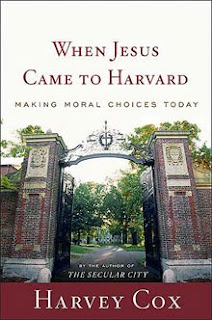 Title: When Jesus Came to Harvard - making moral choices today
Title: When Jesus Came to Harvard - making moral choices todayAuthor: Harvey Cox
Published: NY: Houghton Mifflin, 2004
The well-known Harvard University was first founded in 1636 as a place to train Puritan clergymen for ministry. Through the years, it has shed its religious affiliation to become one of the world’s most famous secular institutions of higher learning. The title of the book can mislead readers into thinking Harvard has become more religious recently. Nothing could be further from the truth. The key incentive lies in the authors belief that Jesus is relevant today. Moreover, in the light of many recent moral failures, there is a greater need to cultivate moral values into the premier institution of learning, so that Harvard graduates will live with integrity and stay on the right side of moral behavior. Harvey Cox's course, "Jesus and the Moral Life" at Harvard is consistently one of the most popular undergraduate courses at Harvard. The teachings of Jesus form the bulwark of this book of moral reasoning from the point of view of Jesus the Rabbi-Teacher. In this book, Jesus is translated not only as a teacher to students of the Bible, but a Rabbi for the world. The course curriculum is based largely on the life of Jesus and the stories he told.
Why You Should Read This Book
Jesus' teachings have universal application. Both Christians and non-Christians have everything to gain and little to lose. Cox says that ‘there is no generation gap’ with regards to Jesus’s teachings (10). Cox maintains that Jesus is relevant and morally significant, especially in a corrupted world of today. The challenge is connecting yesterday's teachings with today's relevance. Two keys are necessary. The first is to remember Jesus is himself a rabbi, a skilled teacher who uses stories as a key teaching tool. The second is to relate Jesus’ stories yesterday via creative imaginations of today.
Key Observations
- Cox focuses not on the content of the stories but the narrative style itself, connecting it to the way people learn, ie via stories.
- Some of the gospel narratives are meant to be sung, rather than analyzed, such as the genealogies (50); [This connects to the need to be imaginative in our applications]
- Jesus read the signs of the times accurately (84); [this forces us to read our own modern signs]
- Religious imagination is necessary in order to see Jesus’s relevance; this is especially when Jesus’s teachings can have more than one interpretations (90);
- Reading the gospel introduces a more personal touch, like Jesus’ road to the crucifixion being of one with anguish; much like modern ethical processes that puts decision-makers to agonizing tough choices (104);
- One conviction Cox maintains is that the declining interest of religious studies does not mean people do not need to grapple with issues religions have long wrestled with. In other words, religion is still alive and well. An interesting observation was when Cox, at one year decided to simply pause from introducing the many interpretations of Jesus, to simply let the students interpret the Sermon on the Mount themselves, as if Jesus words were like Jesus’s Fifth Symphony.
- One of the touching points of relevance is the healing scenes of Jesus. It sparked off many lively discussions and students were typically more receptive to the topic of healing, and Jesus as a Healer (183-4). [Healing is everybody's business.]
This is a not exactly a book for Christians, but that does not preclude believers from learning from it. In fact, some Christians may find Cox's interpretation refreshing. The book treats Jesus primarily as a Rabbi. Some Christians may be uncomfortable with this approach. Yet, I feel that I can understand where Cox is coming from, as his course is supposed to be as open as possible to people of different faiths. What I like in particular is his personal reflection, on Jesus as a person. After all is said and done, he sums up his personal preference, choosing to see Jesus more as his ‘friend,’ highlighting his favorite hymn, What a Friend we have in Jesus. Even though large portions of his book concentrate on Jesus’ teachings, and how they can be applied to daily life, his view of Jesus is remarkably more reverent and respectful than some liberal theologians. Some liberal theologians even question the deity of Christ. Cox’s fascination with Jesus as a person is a surprising admission by the Harvard don. I am personally glad that he decides to tackle the question: “Who is Jesus?” more seriously toward the end rather than simply relegating Jesus to the rank of a 1st century University Professor. His two observations of the theological confusion surrounding Jesus sum up the essence of his view of Jesus' relevance today.
1) Jesus is able to survive all the different views about him, and remained himself;
2) There is nothing new about multiple interpretations about Jesus. Personally, I feel that every person in the world will have to interpret Jesus for him or herself.
“He is where he always was, doing what he was always doing: teaching, chatting, eating and drinking without regard to rank. Today, like then, he meets the same mixture of ‘welcome and hesitation, skepticism and rejection. He runs the constant risk of real trouble with both the religious and the political establishments. But he gently forces people to look at life differently.” (302)There are not many books that openly talk about Jesus, and also appeal to both Christians and non-Christians. Cox is open to his students and also to his own discovery of who Jesus is. For this, I must say I enjoy this book.
ks
No comments:
Post a Comment